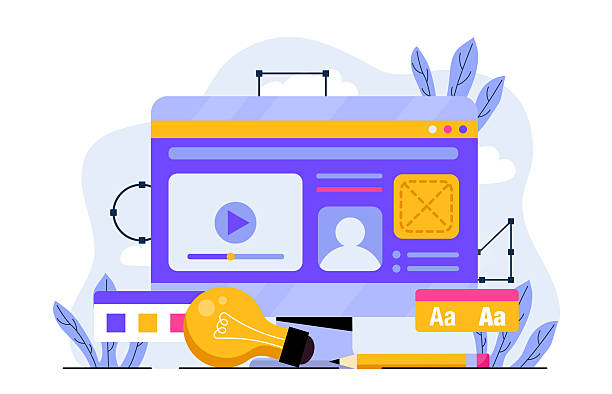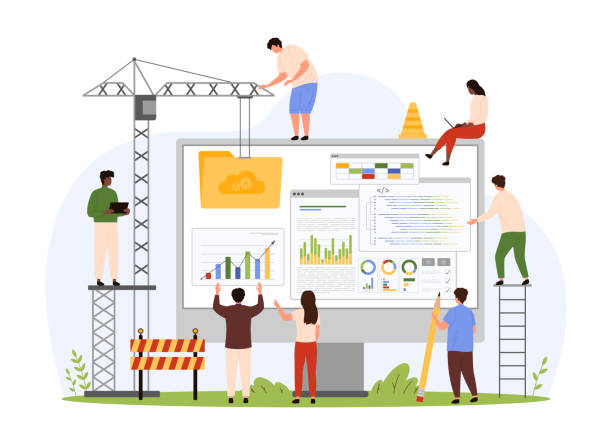Introduction to the Importance of SEO-Optimized Website Design

In today’s digital world, merely having a website is not enough.
For success in the online space, your website must be discoverable and able to attract your target audience.
This is where the concept of #SEO_Website_Design comes in.
SEO-optimized website design means building a website with a structure, content, and coding optimized for search engines like Google.
The main goal of this is to achieve higher rankings in search results and ultimately, increase organic (free) traffic to your website.
A website that is not properly optimized for SEO is like a beautiful shop window on a secluded side street that no one sees.
This is a crucial and educational aspect of digital marketing that every business owner should pay attention to.
When it comes to online competition, websites that adhere to SEO principles are always a step ahead.
They are not only seen but also gain the trust of users and search engines.
This process includes several important aspects, from choosing appropriate keywords to structuring content and optimizing the site technically.
Understanding these principles and implementing them correctly is vital for any business looking for sustainable growth and development online.
This is a complete explanation of the necessity of this type of design that helps you establish your position in the digital market.
Increased Visibility means an increased chance of converting visitors into customers.
Without traffic, even the best products or services will not sell.
SEO is not just a technique, but a long-term strategy that yields sustainable and reliable results.
It is an investment that provides significant returns and helps you stand out among your competitors.
Do you dream of a thriving online store but don’t know where to start?
Rasaw web is your comprehensive e-commerce website design solution.
✅ Attractive and user-friendly design
✅ Increased sales and revenue⚡ Get a free consultation
Basic SEO Principles in Web Design

The foundation of any search engine optimized website design is understanding and implementing SEO principles in the initial design stages.
These principles include On-Page and Off-Page SEO.
On-Page SEO refers to all actions you take within your website to improve its ranking in search results.
This includes keyword selection, optimizing titles and meta descriptions, using Heading tags, image optimization, and proper URL structure.
Each of these elements plays a key role in how search engines understand your content.
One of the most important aspects in this section is content quality and relevance to the target keywords.
Your content should not only be optimized for search engines but also be valuable and engaging for users.
This is an important educational principle that many people overlook.
Excessive use of keywords (Keyword Stuffing) is not only unhelpful but can also harm your site’s ranking.
Instead, keywords should be used naturally and logically throughout the text.
Additionally, website loading speed and its responsiveness (correct display on various devices like mobile and tablet) are other important factors that search engines prioritize.
A fast and user-friendly site provides a better experience for visitors, which in turn sends a positive signal to search engines.
These are essential guidelines for starting any web design project with an SEO approach that will directly impact your site’s long-term success.
Internal link structure is also a vital component.
Internal links help search engines understand your site’s structure and distribute link equity across your pages.
Proper use of internal links can help improve the ranking of specific pages and also guide users to related content.
This is a specialized aspect of SEO that requires careful planning.
The Role of Keywords in SEO-Optimized Website Design and Content Strategy

Keywords are the cornerstone of any SEO strategy and SEO-optimized website design.
They not only help search engines understand your content but also enable you to precisely answer your audience’s questions and needs.
Selecting and researching appropriate keywords is a specialized process that requires careful analysis and a deep understanding of user search behavior.
This section includes identifying short-tail keywords like “coffee” and long-tail keywords like “best coffee maker for small home.”
Longer keywords often have higher conversion rates because users are in the final stages of the purchasing process or searching for very specific information.
For an effective content strategy, you should use keywords naturally in titles, meta descriptions, Heading tags (H1, H2, H3), and in the body of the text.
This is a fundamental guideline: your content must be rich and relevant to the keywords, but never at the expense of content quality and user experience.
Search engines have become increasingly intelligent and can detect low-quality, keyword-stuffed content.
The goal is to create thought-provoking content that encourages more user engagement.
Keyword research also includes competitor analysis.
By examining the keywords your competitors rank for, you can find new opportunities for your content.
This is an important analytical aspect that helps you pursue more effective strategies.
| Feature | Short-tail Keywords | Long-tail Keywords |
|---|---|---|
| Number of Words | 1 to 3 words | 4 words or more (specific phrases) |
| Search Volume | High | Lower but more focused |
| Competition | Very High | Lower |
| Conversion Rate | Usually Lower | Higher (Clearer purchase intent) |
| Example | Buy Laptop | Best Gaming Laptop Under 20 Million |
Technical SEO for Website Ranking Improvement

Technical optimization is one of the main pillars in the process of creating an SEO-optimized website that is often overlooked.
This section includes all non-content aspects of your website that affect how it is crawled, indexed, and ranked by search engines.
Website loading speed, previously mentioned, is one of the most important factors.
Both users and search engines prefer faster sites.
Tools like Google PageSpeed Insights can help you identify problems and provide solutions for improvement.
Another crucial aspect is site structure and information architecture.
A logical and hierarchical structure helps search engines more effectively understand your pages and identify important content.
Using Breadcrumbs and organizing URLs in an SEO-friendly manner also play a role in this.
Additionally, Sitemap XML and robots.txt files are important tools that help search engine crawlers properly index your site and prevent unnecessary pages from being indexed.
Another topic is SSL/HTTPS support.
Google has explicitly stated that HTTPS is a ranking factor.
This protocol enhances your site’s security and builds user trust, both of which are very important for SEO.
This is a specialized tip that will quickly improve your site’s ranking.
Also, managing 404 errors (page not found) and 301 redirects for moved or deleted pages is crucial.
This prevents wasted search engine crawl budget and improves user experience.
This section is an educational and specialized component whose neglect can seriously harm your site’s SEO.
Is your e-commerce site ready to attract maximum customers and increase sales? Rasaw Web transforms your online business with modern and efficient e-commerce website design services.
✅ Increased speed and improved SEO
✅ Excellent user experience on mobile and desktop⚡ Get a free e-commerce website design consultation from Rasaw Web now!
Creating Valuable and SEO-Friendly Content

Content is king; this phrase remains true in the world of SEO.
But not just any content, rather valuable and SEO-friendly content.
This type of content is not only optimized for search engines but is also engaging, informative, and trustworthy for the audience.
Creating content that meets user needs, answers their questions, and provides new information is one of the best ways to attract organic traffic and increase your site’s credibility.
Your content should be deep, comprehensive, and up-to-date.
This is a specialized and engaging process.
When creating content, remember that content format diversity can help attract more audiences.
In addition to textual articles, using videos, infographics, podcasts, and webinars can enrich the user experience.
This thought-provoking content approach signals to search engines that your site is a comprehensive and authoritative resource.
Also, you should regularly update your content to maintain its freshness and relevance to the topic.
This is an important news aspect that shows your site is dynamic and active.
Optimizing content for Featured Snippets and direct answers in search results can also be very effective.
By properly structuring content and providing short, precise answers to frequently asked questions, you can increase your chances of appearing in these prominent Google sections.
This is a professional tip for increasing the visibility of your content.
Furthermore, encouraging social sharing of your content can help increase its reach and credibility.
The more your content is shared, the more positive signals are sent to search engines, ultimately leading to a better ranking for your SEO-driven site design.
This is an important analytical aspect for any content strategy.
User Experience (UX) and its Impact on SEO

User Experience (UX) not only refers to the aesthetics of your website but also to the ease and enjoyment of user interaction with it.
In fact, modern SEO-optimized website design is highly intertwined with UX.
Google and other search engines increasingly prioritize user experience signals for ranking websites.
These signals include Bounce Rate, Dwell Time, number of pages visited per session, and Click-Through Rate (CTR).
Good UX makes users stay longer on your site, view more pages, and ultimately convert into customers.
To improve UX, pay attention to responsive and mobile-friendly design.
Most searches today are conducted via mobile devices, so a site that doesn’t display well on mobile will not only get a bad ranking but also lose many users.
Website loading speed, easy navigation, and attractive visual design are also important UX factors.
This is a fundamental and educational guideline.
Using clear and logical Call-to-Actions, easy-to-fill forms, and organized, scannable content also helps improve user experience.
When users can easily find what they are looking for and interact with your site, their likelihood of returning and becoming loyal customers increases.
This is an analytical and specialized aspect that helps you better understand user behavior.
Ultimately, SEO and UX are two sides of the same coin.
A website optimized for both search engines and users has the highest potential for success in the online space.
This comprehensive approach ensures that your web design investment will yield sustainable results.
Link Building and Domain Authority in SEO-Optimized Website Design

Link Building is the process of acquiring links from other websites to your site.
These links, also known as backlinks, act like a vote of confidence from other sites.
The more and higher quality your backlinks are, the more your site’s Domain Authority increases in the eyes of search engines, which helps your site rank higher in search results.
In SEO-optimized website design, link building is one of the most important Off-Page SEO ranking factors.
The quality of links is more important than their quantity.
A link from an authoritative and relevant site is worth far more than dozens of links from low-quality or spammy sites.
There are various methods for link building, including creating valuable content that naturally attracts links (Link Bait), guest posting on relevant blogs, requesting links from partners or clients, and participating in specialized forums.
This is a specialized and educational aspect that requires patience and continuous effort.
Monitoring your site’s backlink profile and disavowing spammy or malicious links is also of paramount importance.
Bad links can harm your site’s credibility and lead to penalties from Google.
This is a crucial guideline for maintaining the health of your site’s SEO.
| Backlink Type | Description | SEO Impact |
|---|---|---|
| Natural Links (Editorial Links) | Links naturally given due to the high quality of your content. | Highest Value (Organic and Authoritative) |
| Guest Posting Links | Links obtained by writing articles for other websites. | High Value (Controllable and Relevant) |
| Directory Submission Links | Links from web directories (mostly local and business). | Medium to Low Value (Depends on directory quality) |
| Social Media Links (Social Signals) | Links or shares of your content on social media. | Indirect (Influences credibility and traffic) |
| Paid Links | Links obtained in exchange for money. | Dangerous (Can lead to penalties) |
Domain Authority not only helps your ranking but also increases your website trustworthiness in the eyes of users.
A strong and diverse backlink profile indicates a website with valuable and authoritative content.
This is an important analytical aspect that should be continuously reviewed.
Reviewing and Analyzing Website SEO Performance

After implementing the strategies for an SEO-optimized website, the next crucial step is continuous review and analysis of site performance.
SEO is not a one-time process, but rather requires continuous monitoring, data analysis, and ongoing optimizations.
Various tools such as Google Analytics, Google Search Console, and paid SEO tools like SEMrush or Ahrefs help you evaluate your site’s performance in search results.
Using these tools, you can monitor metrics such as keyword rankings, organic traffic, bounce rate, user dwell time, and conversion rate.
Analyzing this data provides you with valuable insights into which strategies have been effective and which need improvement.
For example, if you notice that a specific page has good organic traffic but a high bounce rate, this indicates a problem with the content or user experience on that page.
This is a very important analytical aspect.
In addition, competitor monitoring and new industry trends are also highly important.
By tracking your competitors’ SEO activities and staying informed about new Google algorithms, you can keep your strategy up-to-date and avoid falling behind.
This is a news and specialized part of SEO.
Regular and transparent reporting of SEO performance helps you clearly see your progress and make data-driven decisions.
This part of the SEO process allows you to continuously refine your strategies and achieve the best results.
This is a comprehensive guide to ensuring the effectiveness of your SEO efforts.
Are your e-commerce site visitors leaving before making a purchase? Don’t worry anymore! With Rasaw Web’s professional e-commerce website design services, solve the problem of visitor-to-customer conversion once and for all!
✅ Significant increase in conversion rates and sales
✅ Unparalleled and engaging user experience⚡ Contact us now for a free e-commerce website design consultation!
Common Mistakes in Website Design and SEO to Avoid

On the path to SEO-optimized website design, there are common mistakes that can render your efforts fruitless.
Being aware of these mistakes and avoiding them is just as important as knowing the correct principles.
One of the biggest mistakes is neglecting keyword research.
Creating content without understanding what users are searching for is like shooting in the dark.
This leads to content that will never be seen.
Another common mistake is over-optimization.
Trying to stuff too many keywords into a page, or building low-quality and spammy links, can lead to penalties from search engines.
Google looks for natural, high-quality content, not text stuffed with keywords.
This is a crucial educational point.
Furthermore, ignoring user experience can be disastrous.
A slow site, complex navigation, or lack of mobile responsiveness, even if you have excellent content, will drive users away and harm your site’s SEO.
This is an important explanatory aspect that shows UX and SEO are inseparable.
Neglecting technical SEO, such as the absence of a sitemap, an inappropriate robots.txt file, or crawl errors, can prevent your site from being properly indexed.
These are technical issues that can severely reduce your site’s visibility.
The last point is expecting instant results.
SEO is a marathon, not a sprint.
SEO results appear gradually and require patience and persistence.
Avoiding these mistakes and following a long-term, comprehensive SEO strategy is key to your sustainable success in the online space.
This is a specialized guideline that helps you have realistic expectations.
The Future of SEO-Optimized Website Design and New Trends

The world of SEO is constantly evolving, and what is effective today may change tomorrow.
To maintain ranking and succeed in SEO-optimized website design, you must always be aware of new trends and algorithm changes.
One of the most important future trends is a greater focus on Artificial Intelligence (AI) and machine learning in search algorithms.
Google with systems like RankBrain, BERT, and MUM, is gaining a deeper understanding of search intent and providing more relevant results.
This means your content should not only include keywords but also comprehensively address topics and provide complete and accurate answers.
This is an important news and analytical aspect.
Voice Search is also growing exponentially.
With the increasing use of voice assistants like Siri, Alexa, and Google Assistant, the way users search has changed.
Voice searches are usually longer and closer to conversational language.
Therefore, optimizing for long-tail keywords and natural questions becomes more important.
This is a specialized and important guideline for the future.
User experience, especially Core Web Vitals, will continue to be a key ranking factor.
Google rewards websites that provide a fast, stable, and responsive user experience.
Therefore, investing in optimizing site performance, including loading speed and visual stability, is crucial.
This is an educational and explanatory aspect to ensure the future success of your website.
Finally, E-A-T (Expertise, Authoritativeness, Trustworthiness), which Google uses to evaluate the quality of content and websites, will gain increasing importance.
Building a strong brand, providing content by experts, and acquiring authoritative backlinks help improve your site’s E-A-T.
This is a comprehensive and engaging approach to the future of SEO that helps you stay ahead of the competition.
Frequently Asked Questions
| Question | Answer |
|---|---|
| What does SEO-optimized website design mean? | Designing a website that, in addition to an attractive appearance, is technically and content-wise optimized to achieve higher rankings in search engine results. |
| Why is SEO-optimized website design important? | It leads to increased organic traffic through search engines, improved business visibility, attracting more customers, and ultimately increasing sales. |
| What are the key elements in SEO-optimized website design? | Mobile optimization, high loading speed, high-quality and relevant content, proper use of keywords, appropriate URL structure, and use of title and meta tags. |
| What role does content play in website SEO? | Unique, valuable, informative, and keyword-rich content plays a vital role in attracting users and achieving better rankings in search results. |
| What is Mobile-First Indexing? | A Google approach where the mobile version of the website is prioritized for indexing and ranking. Therefore, website responsiveness for mobile is essential. |
| How can website loading speed be improved? | Compressing images, using caching, optimizing CSS and JavaScript code, using a powerful hosting service, and enabling Gzip compression. |
| What is the importance of keywords in SEO? | Keywords help search engines understand the topic of your page and link it to relevant user searches. |
| What role do Title Tag and Meta Description play? | The Title Tag is the most important element in on-page SEO, and the Meta Description is a summary of the page’s content that encourages users to click. Both are displayed in search results. |
| How does Internal Linking help with SEO? | It helps search engines discover and index different pages of the site and distributes page value across various sections of the site. It also improves user experience. |
| What is the use of a Sitemap in SEO? | An XML file that provides a list of all important pages of the site to search engines to facilitate crawling and indexing of the site. |
And other services of Rasaw Web advertising agency in the field of advertising
Smart Brand Identity: Professional optimization for SEO ranking improvement using an SEO-driven content strategy.
Smart UI/UX: An effective tool to increase website traffic with the help of marketing automation.
Smart Link Building: An innovative service to increase user engagement through intelligent data analysis.
Smart Advertorials: An innovative service to increase sales through custom programming.
Smart Brand Identity: A combination of creativity and technology for user engagement through precise audience targeting.
And more than hundreds of other services in the field of internet advertising, advertising consulting, and organizational solutions
Internet Advertising | Advertising Strategy | Advertorials
Sources
SEO Principles and Link Building
Website Design Portfolio
Digital Marketing Strategy
Online Business Success
💭 For your business to leap forward in the digital world, Rasaw Web Digital Marketing Agency offers innovative and targeted solutions with expertise in areas such as WordPress website design, SEO, and content marketing.
📍 Tehran, Mirdamad Street, next to Bank Markazi, Kazeroun Jonoubi Alley, Ramin Alley, No. 6



